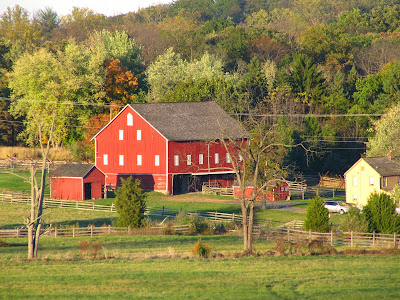October 21 - 23, 2013
Being in Gettysburg, walking and/or driving around the battlefields and seeing a quiet, bucolic landscape is mind-boggling to think of what happened here in the Civil War. The Battle of Gettysburg raged on for three days, July 1 - 3, 1863, and was the war's bloodiest battle with 51,000 casualties (killed, wounded, captured, or missing). Although the war continued for another two years, many consider this battle the turning point of the war. During the four years of the war about 620,000 soldiers and sailors died, which was just under two percent of the population.
The first five pictures are from the Gettysburg Cyclorama which brings Pickett's Charge to life. Pickett's Charge was the climax of the Battle of Gettysburg. The Cyclorama is a 377-foot circular painting by 42-feet high, painted by Paul Phillippoteaux and five assistants in 1884. Along with sound, lighting and life size objects in the foreground, one is immersed in the battle with a 3-D effect.
Barn at the McPherson Farm, buildings on the farm were used as a hospital by the Confederates. Just to the west of this barn is where the Battle of Gettysburg began on July 1, 1863.
Reynolds Woods
Oak Hill
Eternal Light Peace Memorial on Oak Hill
July 1 - A large apple orchard was on the southern slope of Oak Hill. The hill's elevation allowed Confederate artillery to fire at Union forces on Seminary and McPherson ridges. After a fierce fight, the Confederates succeeded in forcing the Union troops to abandon Oak Hill.
Virginia Memorial, Gen. Robert E. Lee on his horse, Traveller. The statues at the base represent people who left their jobs to join the Confederate Army - a professional man, a mechanic, an artist, a boy, a businessman, a farmer and a youth.
Ready, Aim, Fire!!!
Little Round Top, July 2, 1863, the Union Army succeeded in defending this hill which was on high ground and gave the Union forces a sweeping view to the north and west
Little Round Top
The Trostle Barn, where Union Major Gen. Daniel Sickles made his headquarters. Sickles was quite controversial as a general, maybe because prior to the war he was a politician. There are some who believe that had the Union lost at the battle of Gettysburg, it would have been because of Sickles. He continued his political career after the war and he did redeem himself several years later when he introduced a bill to create Gettysburg National Military Park.
Sachs Bridge, built in 1852, near Gettysburg. It was used by
both Union and Confederate Armies during the Civil War.
Marsh River as seen from inside Sachs bridge.
Interior of Sachs bridge
The Pennsylvania Memorial, the largest state monument in the park
Adams County Library, Gettysburg
Adams County Courthouse, Gettysburg, built in 1858. During the Battle of Gettysburg the building served as both a command post and as a hospital.
In great deeds something abides,
On great fields something stays.
Forms change and pass; bodies disappear;
but spirits linger . . .
And generations that know us not
and that we know not of,
heart-drawn to see where and by whom
great things were suffered and done for them,
shall come to this deathless field,
to ponder and dream.
Union General Joshua Lawrence Chamberlain,
"Spirits Linger," Gettysburg, October 3, 1889




































No comments:
Post a Comment